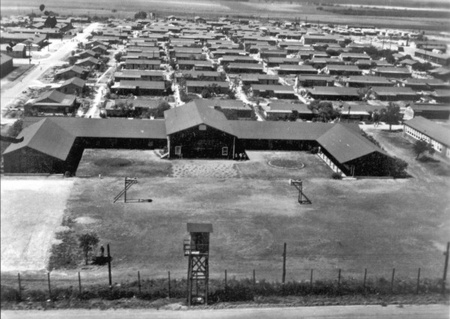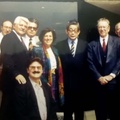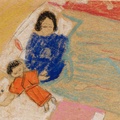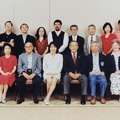The end of the war between Japan and the United States in August 1945 did not bring peace and freedom to the thousands of Japanese immigrants who lived in various countries in Latin America. This was particularly true for those who had been forcibly relocated to concentration camps in the United States and remained incarcerated. The war was over and their future was still uncertain, as they didn’t know if they would be repatriated to Japan or if they could return to the countries where they had lived most of their lives and where their children had been born.
Before the war started in December 1941, the U.S. government quickly built 10 concentration camps and other facilities to incarcerate 120,000 Japanese and their descendants living in the United States. As part of this measure, the U.S. government also declared that the Japanese people living in various Latin American countries were “extremely dangerous” and sought to have them imprisoned in concentration camps in the United States.
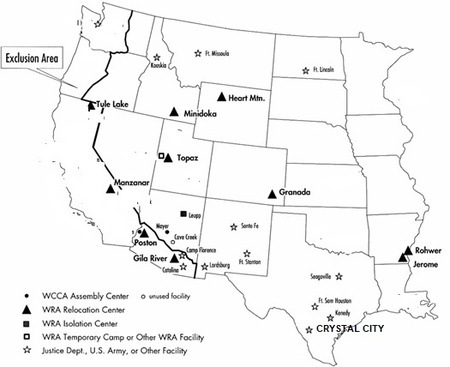
Because of this, 2,000 immigrants living in Latin American countries were sent to the U.S internment camps; however, those most affected were the Japanese living in Peru. More than 1,800 people, among them women and children, were practically kidnapped and put on several ships to the United States starting in April 1942. The U.S. government chartered a vessel, Etolin, which departed from the port of Callao with 141 Japanese people (12 of whom were officials at the Japanese embassy in Lima). The Japanese sent to the United States in that first forced removal were men; they were later sent to join their wives and children who had “voluntarily” requested to be transferred to the U.S. camps in order to keep their families together.
The first people from Peru who were imprisoned were sent to Kenedy and Seagoville, both in Texas. Once their relatives arrived, the U.S. government opened a new camp in the town of Crystal City, south of San Antonio. Eventually, 4,000 people were imprisoned there, the majority of whom were Japanese, although some Germans and Italians were also brought from Latin American countries.
The camp was managed and monitored by U.S. immigration officials, but the prisoners were organized into several commissions that were responsible for solving day-to-day problems related to housing, food, and health.
The Japanese, who had vast experience in agriculture, actively participated in growing a variety of vegetables including tomatoes, pepper, and beets. Professionals became teachers in the schools created for children and youth. There were also doctors and nurses who worked in the camp hospital, which in addition to caring for the sick also delivered the babies who were born during the war.
The women, for their part, were involved in economic activities. They started a sewing business to make bedding, including quilts, sheets, and pillowcases. They also made shirts and pants during a time when these products were in high demand, as the U.S. economy was largely focused on producing materials for the war. Generally, any other activity needed in Crystal City was paid at a rate of 10 cents per hour of work.
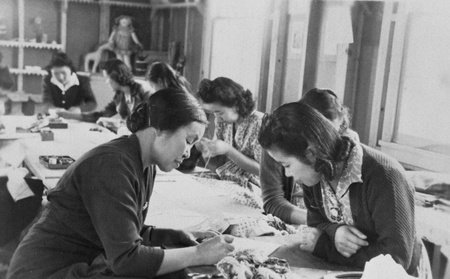
Throughout the war, these families tried to make their daily lives as pleasant as possible. In reality, Crystal City was one of the places where internment conditions were dramatically better—according to the testimonies of those imprisoned there—compared to other camps. Families and children organized social activities and festivals that brought together internees from Latin America and the United States, all of whom succeeded in expressing a strong and cohesive sense of community during these difficult times.
Through the more than three years of the war, some of the Japanese prisoners were exchanged for prisoners captured by Japan, such that the immigrants became hostages of war. Faced with internment, many immigrants allowed themselves to be exchanged and were returned to Japan despite having lived most of their lives in another country. In 1944, two large exchanges took place that included a total of 1,260 Japanese-Peruvians who, somewhat involuntarily, decided to return to Japan aboard a Swedish ship, the Gripsholm, which was used during the war to carry out prisoner exchanges.
Towards the end of the war in 1945, Crystal City had a population of 3,374 internees, of which 2,371 were of Japanese origin and the rest were German.
Most of the internment and detention camps were closed by late 1945, but the Crystal City camp continued to function until 1947. The legal situation of the internees in the camp was unclear for several reasons: first, because they had involuntarily entered the United States as “foreign enemies”, and also because some were Peruvian citizens while others had been born in the United States. The close to 400 internees who remained in Crystal City were from Peru and refused to be sent back to Japan, without knowing what their final destination would be since the Peruvian government did not allow them to return there.
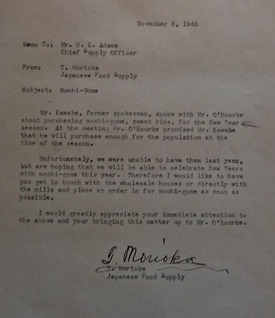
In these conditions, the immigrants prepared for New Year’s Eve of 1946 in the traditional Japanese way, making rice patties using wooden mallets known as mochi. The tradition of celebrating and making this food not only enabled them to greet the New Year in a enjoyable way, but also provided an opportunity to work together to prepare the food and ring in the New Year.
We don’t know if the families were able to greet the New Year by preparing traditional Japanese food, but there is no doubt that their hard work and solidarity continued years later. In 1946, 364 internees were “paroled” to work at a Seabrook Farm, a food processing plant, in New Jersey. This was the beginning of another long battle to achieve recognition from the U.S. government of the serious violations of their human rights, a struggle we will discuss at another time.
© 2020 Sergio Hernandez Galindo


